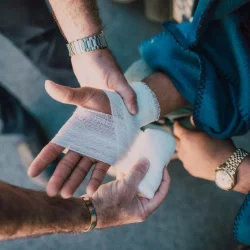How Dashcam Footage Can Help Your Car Accident Claim
Car accidents can be chaotic, stressful, and complicated, especially when determining fault. In many cases, insurance companies rely on driver statements, police reports, and witness testimony to assess liability. However, these sources can sometimes be biased or inaccurate. That’s where dashcam footage comes in. Dashcams, small cameras mounted on a vehicle's dashboard or windshield, record the road ahead and can provide crucial evidence in the event of an accident.
In this blog, we'll explore how dashcam footage can strengthen your car accident claim, how to use it effectively, and important considerations to keep in mind.
Why Dashcam Footage Is Valuable for Car Accident Claims
Dashcam footage serves as an impartial witness that records events as they happen. Unlike human memory, which can be flawed or influenced by emotions, video footage provides a clear, objective view of the accident scene. Here’s why dashcam footage is so valuable:
1. Provides Clear Evidence of Fault
Determining fault is often the most contested part of a Harrisburg, PA car accident claim. Dashcam footage can show:
- The exact moment of the collision
- Traffic signals and signs at the time of the accident
- Speed and direction of the vehicles involved
- Lane changes or traffic violations
Example: If another driver ran a red light and hit your vehicle, dashcam footage can clearly capture the traffic signal and the other driver’s actions, making it difficult for them to dispute fault.
2. Protects Against False Claims and Insurance Fraud
Unfortunately, some individuals stage accidents or exaggerate damages to exploit insurance companies. Dashcams can expose fraudulent claims, protecting you from being held responsible for something you didn’t do.
Example: If someone claims you rear-ended them when they actually reversed into your car intentionally, dashcam footage can prove what really happened.
3. Strengthens Your Insurance Claim
Insurance adjusters rely on evidence to determine compensation. Dashcam footage provides undeniable proof, which can:
- Speed up the claims process
- Increase the chances of a favorable outcome
- Reduce disputes over liability
4. Captures Road Conditions and Environmental Factors
Road conditions, weather, and other environmental factors can play a role in accidents. Dashcams can capture:
- Wet or icy roads
- Obstructions or debris on the roadway
- Poor visibility due to fog or heavy rain
This information can be crucial when explaining how the accident occurred.
5. Documents Hit-and-Run Incidents
In hit-and-run accidents, identifying the fleeing driver is often challenging. A dashcam can capture the license plate, vehicle make, and model of the at-fault driver, increasing the chances of holding them accountable.
How to Use Dashcam Footage Effectively in Your Claim
Having dashcam footage is helpful, but knowing how to use it correctly is just as important. Here’s what you should do after an accident:
1. Preserve the Footage Immediately
Dashcams often loop recordings, which means new footage can overwrite older files. Save the relevant video as soon as possible to prevent losing critical evidence.
2. Make Multiple Copies
Create copies of the footage and store them in different locations (e.g., cloud storage, USB drives) to avoid losing the evidence.
3. Submit the Footage to Your Insurance Company
Provide your insurance adjuster with a copy of the footage when filing your claim. Ensure the video shows:
- The moments leading up to the accident
- The collision itself
- The aftermath and immediate surroundings
4. Provide Context with Additional Evidence
While dashcam footage is powerful, it should be used in conjunction with:
- Police reports
- Photos of the accident scene and vehicle damage
- Witness statements
- Medical records if injuries occurred
Combining these forms of evidence strengthens your claim and provides a comprehensive view of the incident.
5. Consult a Personal Injury Attorney
An experienced attorney can review the footage and determine the best way to use it in your case. They can also handle communications with insurance companies and opposing parties to ensure your rights are protected.
Legal Considerations for Using Dashcam Footage
Before using dashcam footage, be aware of legal considerations that could affect its admissibility:
1. Privacy Laws
In some states, recording audio without consent may violate wiretapping laws. Most dashcams record video only, but if yours captures audio, check your state’s laws regarding consent.
2. Admissibility in Court
Courts typically accept dashcam footage as evidence if it:
- Is clear and unaltered
- Accurately depicts the events
- Was legally obtained
Always keep the original footage intact to avoid accusations of tampering.
3. State-Specific Regulations
Some states have specific laws about where dashcams can be mounted. Ensure your dashcam placement complies with local regulations to avoid fines or disqualified evidence.
Tips for Choosing and Using a Dashcam
Investing in a reliable dashcam can be a game-changer. Here are some tips to get the most out of your device:
- Choose a Dashcam with High Resolution: Clear footage is crucial. Aim for at least 1080p resolution.
- Look for Wide-Angle Lenses: A wider field of view captures more of the road and surrounding area.
- Consider Dual Cameras: Some dashcams record both the front and rear views, providing more comprehensive coverage.
- Use Dashcams with GPS and Speed Tracking: These features provide additional data to support your claim.
- Regularly Check and Maintain Your Dashcam: Ensure the camera functions properly and the lens is clean for clear recordings.
- Secure the Device Properly: Mount the dashcam where it won’t obstruct your view but still captures a full view of the road.
Common Scenarios Where Dashcam Footage Is Helpful
Rear-End Collisions:
Footage can show if the other driver was following too closely or if you were forced to brake suddenly due to another hazard.
Intersection Accidents:
Dashcams can capture which driver ran a red light or failed to yield.
Road Rage Incidents:
Video evidence can document aggressive driving behavior or intentional collisions.
Pedestrian Accidents:
Dashcams may clarify whether a pedestrian unexpectedly entered the roadway or if the driver was at fault.
Limitations of Dashcam Footage
While dashcams are incredibly useful, they’re not perfect. Here are some limitations to be aware of:
- Limited Field of View: Single-lens dashcams may not capture side impacts.
- Nighttime Visibility: Cheaper models may struggle to record clear footage in low light.
- Obstructions: Dirty windshields or weather conditions can obscure footage.
- Technical Failures: Power issues or full memory cards can prevent recording.
Dashcam footage can be a crucial piece of evidence in your car accident claim. It provides an unbiased account of events, helps determine fault, protects against fraudulent claims, and can expedite the insurance process. To maximize the benefits, ensure you preserve the footage, understand the legal considerations, and consult with an experienced personal injury attorney.
Accidents are unpredictable, but having a dashcam ensures you're prepared. Investing in this small device can make a significant difference in protecting your rights and securing the compensation you deserve after an accident.
More to Read:
Previous Posts:




